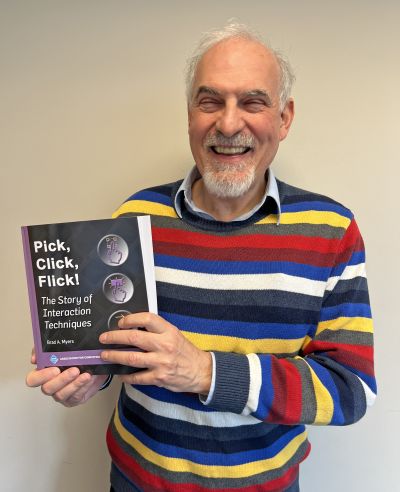Related People
Brad Myers
Myers Publishes Book on Interaction Techniques
A new book from Brad A. Myers, the director of the Human-Computer Interaction Institute at Carnegie Mellon University, explores the history, current and future design of interaction techniques.
The book, “Pick, Click, Flick! The Story of Interaction Techniques,” digs deep into the details of interaction techniques and how they work, often with information from the techniques’ inventors.
Although “interaction technique” (IxT) may not be a common household term, many of the elements of IxTs are likely familiar to those who have interacted with computers, such as clicking an OK button, selecting a checkbox, scrolling down a page, or entering text in an input field. These common actions are all examples of interaction techniques – objects on a computer screen that you, the user, interact with to provide input to the computer.
IxT designers must consider many elements for each, even for the interactions that seem basic. A checkbox, for example, must adapt to indicate the two main states (unchecked and checked), but also show intermediate states (like hover state), and support multiple ways of interacting (using a mouse or a keyboard). The simple checkbox example from Chapter 1 of the book could have 48 states to consider, which sets an early tone for the complexity and importance of the subject of IxTs.
Myers, the Charles M. Geschke Director and Professor, has decades of experience in the area of interaction techniques, and has used, studied and even invented new ones throughout his career.
In 2014, Myers was brainstorming ideas for a new elective course to offer to Carnegie Mellon students. His preparation to teach what would become 05-440 / 05-640: Interaction Techniques started the compilation of information for this book.
Myers’ book goes deeper into the mechanics of how interaction techniques work than other technology history books, which is an intentional distinction.
“History books virtually never dig into the details of how the interaction techniques work, and the details matter,” said Myers. “I thought it was important to capture those details, especially while the knowledgeable people are still around.”
Myers then invited many of those people to visit his class, and the interviews featured in the book are based on those guest lectures.
“It was definitely a highlight of the class to have these old and young people describe the process of their inventions, and to see the early iterations of the ideas as they evolved into the familiar ones that were released,” Myers added. “The interviews nicely augment the information in the other parts of the book with personal details of the process.”
Myers’ goal for “Pick, Click, Flick!” is to be a useful read for anyone interested in why we interact with electronic devices the way we do, for the designers who will create the interaction techniques of tomorrow, and even for consumers who want to get the most out of their own digital interactions. He also hopes the book will inspire new research to discover the next ideas in the field.
The four-part book gives a thorough overview of IxT. Part 1 is a history of desktop and mobile interaction techniques. Part 2 explores a variety of interaction techniques, with chapters dedicated to everyday items including “Pointing Devices” such as a mouse or touchpad, many different kinds of “Menus,” and “Text Entry and Editing.” Part 3 focuses on using, designing, and implementing interaction techniques, and Part 4 features interviews with many of the inventors and original designers of the IxTs. These interviews cover the origins of many of the digital interactions we are now accustomed to using, including copy and paste, desktop icons, and spreadsheets.
For example, Chapter 24 features an interview with David Canfield Smith, who first defined a computer icon during his 1975 thesis. Smith recently commented on the book, “No one has done more than Brad Myers to turn the art of computer user interface design into a science. Now with this masterful book, he has put a fitting cap on his eminent career... It is a remarkably thorough coverage of the history of a vibrant inventive field.”
The book has also been endorsed by other leaders in the field of HCI, such as Ben Shneiderman, Don Norman, Jakob Nielsen, and Hiroshi Ishii.
“Pick, Click, Flick! The Story of Interaction Techniques” is Myers’ fourth book and is available in hardcover, paperback, and digital forms from the publisher ACM Books.
For those attending the 2024 ACM SIGCHI Conference in Honolulu, Hawaiʻi, Myers will be hosting a book signing event on Monday, May 13 and teaching a short course (Course #C04: Interaction Techniques – History, Design and Evaluation) on Tuesday, May 14.
For more information about “Pick, Click, Flick! The Story of Interaction Techniques,” visit ixtbook.com.


